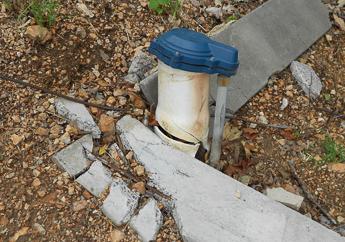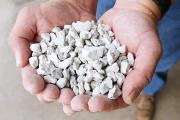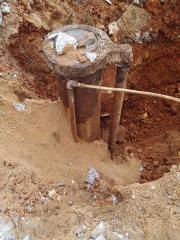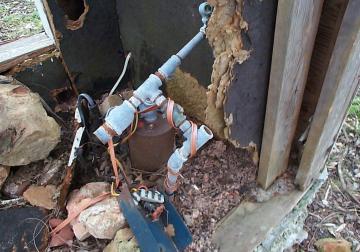Missouri Geological Survey Director: Carey Bridges, RG

Nearly 3 million Missourians depend on water wells for their drinking water. Over the years, construction methods for water wells have evolved from being dug by hand, bored with augers, and hammered by cable tool rigs to drilling with air rotary or sonic drill rigs. Over time, thousands of water wells were abandoned without being properly plugged. A well is considered abandoned when it can no longer produce water, transport water to its point of use, or causes a contamination risk to groundwater and has not been used for two or more years.
Abandoned wells can present a physical hazard and threat to groundwater. Hand-dug wells with wide openings pose a life-threatening hazard to people and animals. Abandoned wells that reach deep into groundwater aquifers serve as a conduit for contamination.
Locating Abandoned Wells
Abandoned wells exist in every county of the state. An obvious sign of an abandoned well is casing pipe sticking out of the ground. A concrete slab or man-made cover may be a sign of a pit where an abandoned well is located. Windmills or hand pumps are almost always associated with abandoned wells. If an abandoned well is discovered, please contact us for assistance at 573-368-2165 or email welldrillers@dnr.mo.gov.
Who May Plug an Abandoned Well
State law and supporting regulations require abandoned wells to be plugged. This responsibility usually falls on the landowner. Landowners may plug abandoned wells on their property themselves. Special circumstances exist where the department may require the well to be plugged by a permitted contractor. If a landowner hires a person to plug a well, the hired person must have a well or pump installation permit issued by the department. An exception to the permit rule applies to hand dug wells and augered wells (no greater than 80 feet in depth). Missouri Well Construction Rule Chapter 3, 10 CSR 23-3.110 describes plugging specifications for all water well types.
Guidance
Chlorination
Any water in an abandoned well must be disinfected prior to plugging. Wells are directly connected to groundwater and must be bacteria free when plugged. To disinfect a well, pour 1 gallon unscented household bleach in the well before adding clean fill or grout material. The following links provide helpful information about properly disinfecting a well:
Approved Grout

The most commonly used grout is sodium bentonite, which is a swelling clay. The most common form of bentonite grout is three-eighths inch chips. Bentonite also comes in coated pellets and can be made into a slurry using powder. Wells may also be plugged using cement grout, which is a mix of one 96 lb. bag of Portland cement with 6 gallons of clean water.
Concrete is not acceptable. This is due to the varied size of rock mix with concrete that may cause the well to bridge.
Fill Material
If the well is deep, it is permissible to add clean fill to offset the cost of grout when plugging a well. Examples of clean fill include pea gravel and varied-size agricultural lime or sand. Clean fill is NOT a substitute for grout. A grout plug always is required for drilled wells. Clean fill may be used from total well depth to 50 feet below the bottom of the well casing. If the casing depth is unknown, the well must be filled completely with grout. Hand-dug wells maybe plugged entirely using clean fill.
Required Reporting
Sections 256.614, RSMo require that the plugging of abandoned wells be registered with the department within 60 days of the work being completed. Staff will review the plugging registration report to ensure that the well was plugged in accordance with Missouri Well Construction Rules.
If the report shows the well was plugged properly, a registration number will be issued and a letter will be sent to the landowner. It is important to keep this documentation, because some lending institutions and local governments require such proof upon sale or refinancing.
The plugging of abandoned wells must be reported to the department and can be done by using Well Installation Online Services or by submitting the appropriate form.
- Oil and Gas Notice of Intention to Plug Form 780-0214
- Oil and Gas Well Plugging Report Form 780-0217
- Monitoring Well/Test Hole/Soil and Geotechnical Boring Plugging Registration Report Form 780-2161
- Water Well/Heat Pump Plugging Registration Report Form 780-1603
Specific Well Plugging Requirements Based on Well Type
Domestic (Private) Bedrock Wells

Bedrock water supply wells typically have steel or PVC casing that is 6 inches in diameter. The amount of casing and the total depth of these wells varies widely with geologic conditions across the state.
To plug a bedrock well, remove the pump and any debris. Dig around the casing 2 feet below the surface and cut the casing off. Clean fill material may be used from the bottom of the well to a point 50 feet below the bottom of the casing. Grout is then used from the top of the fill to within 2 feet of the surface, extending into the excavated area at least 1 foot. The remaining 1 foot should be filled with clay or clay-rich soil. If the casing depth is unknown, the well must be plugged full length with approved grout.
If the well is located in a well house with a concrete floor or in an area surrounded by asphalt, cut the casing flush with the hard surface. Follow the steps for plugging, but add a 1-foot cement cap at the top of the well.
Domestic (Private) Unconsolidated Material Wells

In general, water wells that are constructed in unconsolidated materials, such as clay, silt, sand or gravel, have small diameter casing less than 6 inches, or large diameter casing 12 inches or greater. These wells are found mostly in northern Missouri, along the Missouri River and in the Bootheel area. The casing pipe is usually PVC. The lower portion of the well below the casing is a slotted pipe or well screen. This allows water to enter the well without the sand and gravel filling the well or interfering with the operation of the pump.
To plug an unconsolidated material well, remove the pump and any debris. Dig around the casing 2 feet below the surface and cut the casing. If the well is in an agricultural area, the casing must be cut 3 feet below surface. If the well is less than 200 feet deep, use clean fill material to a depth of 20 feet below the surface. Add grout to fill the upper 20 feet extends into the excavated area at least 1 foot. Fill the remaining excavated area with clay or clay-rich soil. For wells greater than 200 feet in depth, a 50-foot grout plug is required above the clean fill.
If the well is located in a well house with a concrete floor or in an area surrounded by asphalt, cut the casing flush with the hard surface. Follow the steps for plugging but add a 1-foot cement cap at the top of the well.

Hand-dug Wells
Wells that were dug by hand usually are 3-6 feet in diameter and 10-30 feet in depth, and are usually lined with material such as brick or fieldstone. Wells that are less than 10 feet in depth are exempt from plugging rules.
To plug a hand-dug well, carefully push in the upper 2 feet of the lining. Fill the well to within 2 feet of the surface with clean fill. The remainder of the well should be filled with clay or clay-rich soil.
Cisterns
Cisterns are considered water storage structures and are exempt from plugging rules. Since cisterns pose a physical threat, the department recommends landowners completely fill a cistern with clean fill.
Public Bedrock Water Wells
Wells that serve public facilities (e.g., cities, water districts, motels, restaurants, schools, subdivisions) have more stringent plugging requirements. Public facilities usually require a large volume of water, which requires wells to be drilled deep into groundwater aquifers. The depth of some wells are 1,000 feet or greater. Contact us for plugging specifications for public wells.
High Yield Bedrock and High Yield Unconsolidated Wells
A well that produces 70 gallons per minute or more is considered a high yield well. Similar to public wells, high yield wells are often very deep and require specific plugging specification to protect the groundwater aquifer. Plugging rules allow high yield bedrock wells to be plugged full length with cement slurry without prior department approval. For any other plugging methods, contact us for plugging specifications for high yield wells.
Nothing in this document may be used to implement any enforcement action or levy any penalty unless promulgated by rule under chapter 536 or authorized by statute.
For more information
Geological Survey Program
Missouri Geological Survey
P.O. Box 250
Rolla, MO 65402-0250
United States
